Hi Friends Sub
to follow you will find another interesting scientific sheet of our friend biologist dr. Luigi Esposito.
Greetings and good bubbles to all
BARILE
(Tonna galea)
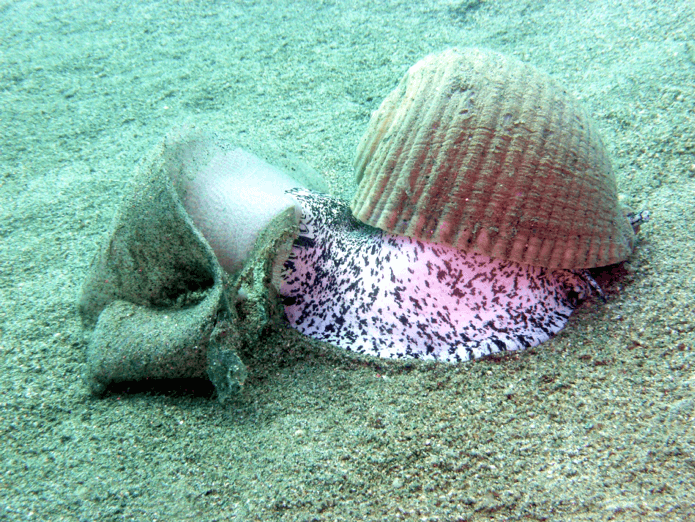
KINGDOM: Animal
PHYLUM: Mollusca CLASSE: Gasteropoda
ORDER: Mesogastropoda FAMILY: Tonnidae
DISTRIBUTION: Mediterranean and Atlantic Ocean
DESCRIPTION: This gastropod lives on sandy and muddy bottoms. The shell is large and spherical, almost spherical, the opening is wide and elongated at the bottom. The surface is covered with large flattened spiral cords. The color is yellowish brown. Its truly extraordinary ovigere masses are made up of a long gelatinous ribbon
SIZE: The height is 25 cm (approx.) And 15-30 cm in diameter.
ALGA PALLA VERDE
(Codium bursa)
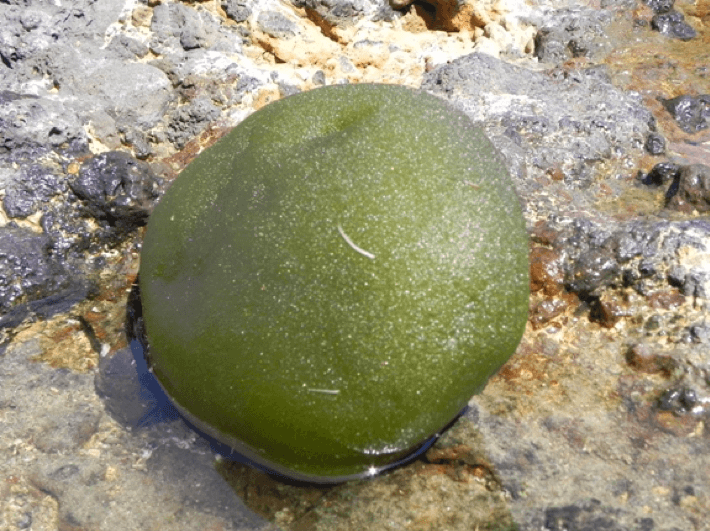
KINGDOM: Vegetable
PHYLUM: Phycophyta CLASS: Ulvophyceae
ORDER: Codiales FAMILY: Codiacee
DISTRIBUTION: It is frequently found in the Mediterranean Sea, up to 50 meters deep, on a rocky bottom or accompanied by Posidonia oceanica.
DESCRIPTION: Spherical in shape, increasingly depressed in the center and flattened. Rough to the touch, hollow inside and easily compressible. Green, both light and dark. It can be confused with a sponge because of its consistency.
DIMENSION: It also reaches considerable dimensions, of about 40 cm in diameter
CAULERPA A GRAPPOLI
(Caulerpa racemosa)
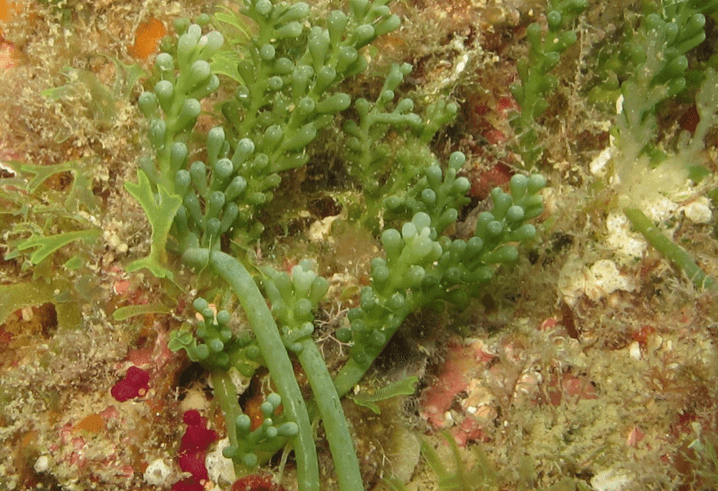
KINGDOM: Vegetable
PHYLUM: Chlorophyta CLASS: Ulvophyceae
ORDER: Bryopsidales FAMILY: Caulerpaceae
DISTRIBUTION: Red Sea, Mediterranean Sea. Immigrated from the Red Sea since 1950.
DESCRIPTION: Species of pale green color. Sprigs erect, often from one to a few centimeters long, simple or bifurcated, covered with short club-shaped or even rounded twigs.
ENVIRONMENT: It is found on muddy and sandy bottoms at low depth or on soft rocky substrates, up to about 60 m.
DIMENSION: From 8 to 10 cm in height.
CAULERPA FOGLIOSA
(Caulerpa prolifera)
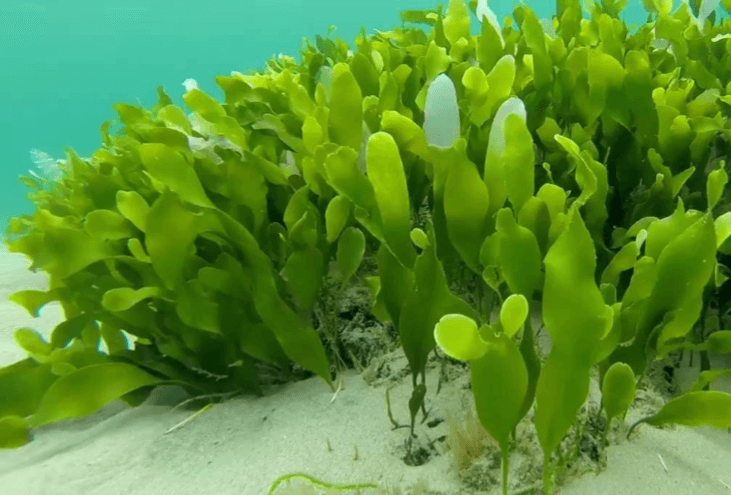
KINGDOM: Vegetable
PHYLUM: Chlorophyta CLASS: Ulvophyceae
ORDER: Bryopsidales FAMILY: Caulerpaceae
DISTRIBUTION: Mediterranean (rarer in northern areas), tropical and subtropical Atlantic. Sandy or muddy bottoms, from 1 to 15-20 m, often near the Posidonia meadows.
DESCRIPTION: consisting of a thin stole, creeping on the bottom and up to 1 m long and fixed to the substrate, and fronds, similar to flattened and lanceolate leaves. The consistency is quite leathery due to the thick cuticle coating. The color is green.
DISTINCTIVE CHARACTERS: The species forms small grasslands. Limiting is the temperature: it is a thermophilic alga.
CETRIOLO DI MARE
(Holoturia tubulosa)
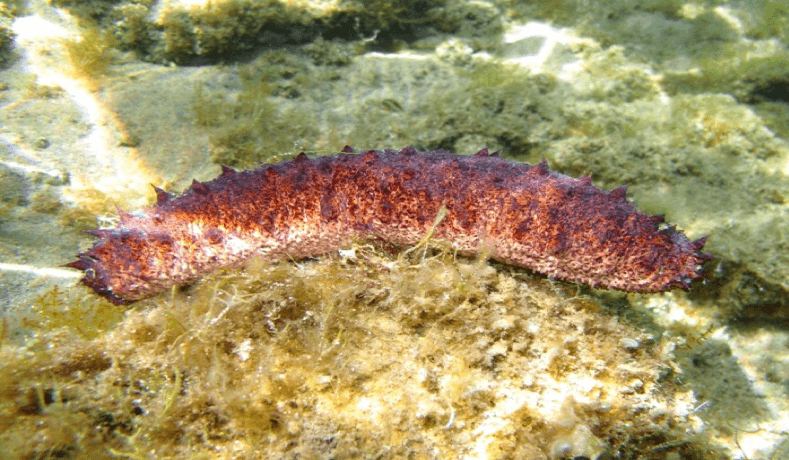
KINGDOM: Animal
PHYLUM: Echinodermata CLASS: Holothuroidea
ORDER: Aspidochirota FAMILY: Holothuria
DISTRIBUTION: Municipality throughout the Mediterranean. It lives from 0 to 100 meters deep.
DESCRIPTION: The body shape is cylindrical. The dermal skeleton is reduced to a set of microscopic plates that are included in a thick dermal layer.
The genus is characterized by having 15-30 buccal tentacles. The part of the body that lies on the bottom is slightly flattened. The color is red-brown or brown-purple.
ENVIRONMENTS: on sandy, muddy, stony bottoms. Both in the cliffs and in the Posidonia prairie.
GRANCHIO CORRIDORE
(Pachygrapsus marmoratus)
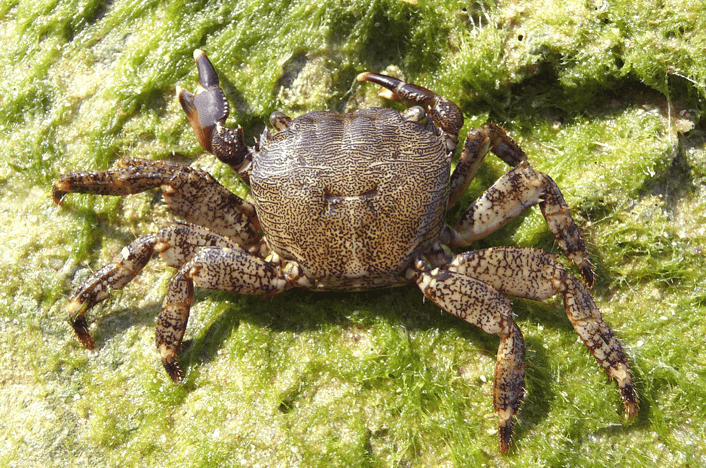
KINGDOM: Animal
PHYLUM: Arthropoda CLASS: Malacostrata
ORDER: Decapoda FAMILY: Grapsidae
DISTRIBUTION: Mediterranean, Black Sea and Eastern Atlantic.
DESCRIPTION: It has a typical quadrangular carapace of about 4-5 cm. It has a very dark brown-violet or greenish back with yellowish streaks. It is very fast when traveling. His diet is mainly composed of organic detritus. He lives about 3-4 years
ENVIRONMENTS: It lives in rocky areas, in the intertidal zone (tidal zone). It is very common, it is often found in the cracks of the rock and in the evening hours it comes out of the den and walks on the rocks in the dry in search of food.
PEPERONCINO DI MARE
(Tripterygion tripteronotus)
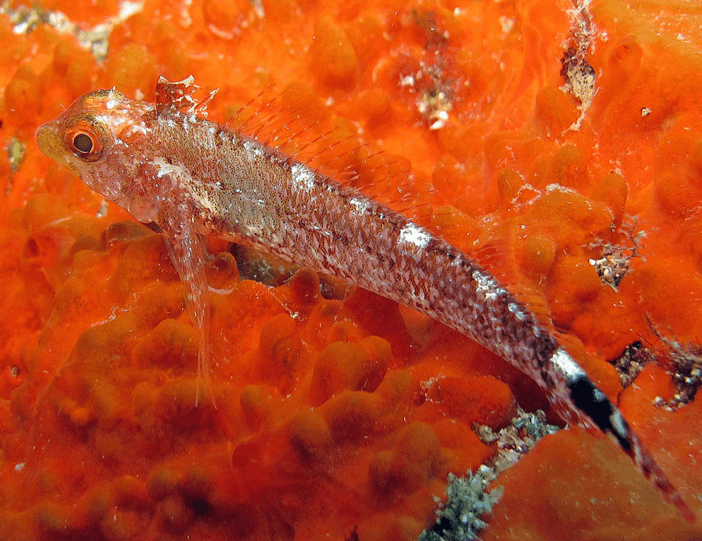
KINGDOM: Animal
PHYLUM: Chordata CLASS: Actinopterterygii
ORDER: FAMILY Perciformes: Tripterygiidae
DISTRIBUTION: Mediterranean Sea and Eastern Atlantic.
DESCRIPTION: The genus Tripterygion is characterized by having reduced dimensions, tapered, elongated body, pointed snout and three distinct dorsal fins. Males have a red background color with a darker head. Along the back they have lighter transversal bands.
The females on the other hand have a brown color crossed on the back by light transversal bands.
ENVIRONMENTS: rocky environment with many crevices in which to hide.
DIMENSIONS: It reaches 8 cm in length
COCCIOLONE GRANDE
(Cymatium parthenopeum)
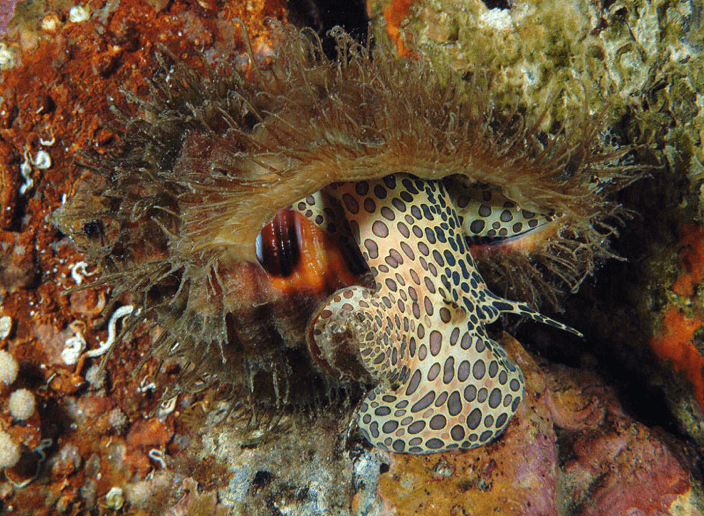
KINGDOM: Animal
PHYLUM: Mollusca CLASS: Gastropoda.
ORDER: Sorbeoconcha FAMILY: Ranellidae.
DISTRIBUTION: Mediterranean from the central Tyrrhenian to the Ionian, Indian and Pacific Oceans.
ENVIRONMENT: Present on coastal screes and hard and algae-rich bottoms.
DESCRIPTION: Characterized by the hairy mullet covering the whole shell and the color of the yellow mollusk coat.
It has brown or bluish spots and the shell is sturdy.
SIZE: 15 cm in length.
DISTINCTIVE CHARACTERS: The shell has a very elongated shape
DONZELLA PAVONINA
(Thalassoma pavo)
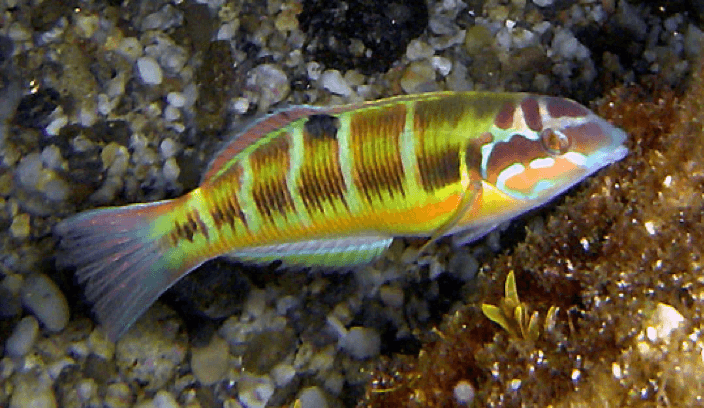
KINGDOM: Animal
PHYLUM: Chordata CLASS: Actinopterygii
ORDER: Perciformes FAMILY: Labridae
DISTRIBUTION: Backlights illuminated from 0-20 m depth.
DESCRIPTION: Tapered body, massive head, small mouth. Single dorsal fin. It has a beautiful and extraordinary livery of a golden yellow green color.
ENVIRONMENT: Mediterranean Sea and Eastern Atlantic Ocean.
DIMENSIONS: Thalassoma’s young grow rapidly; adults of 6-7 cm in length are considered adults. The female reaches 18 cm while the male reaches 25 cm.
DISTINCTIVE CHARACTERS: It prefers warm climates and is hermaphroditic; in the juvenile period it develops the feminine characteristics while during the maturation it acquires the masculine ones.
SPUGNA A CORNA DI DAINO
(Axinella damicornis)
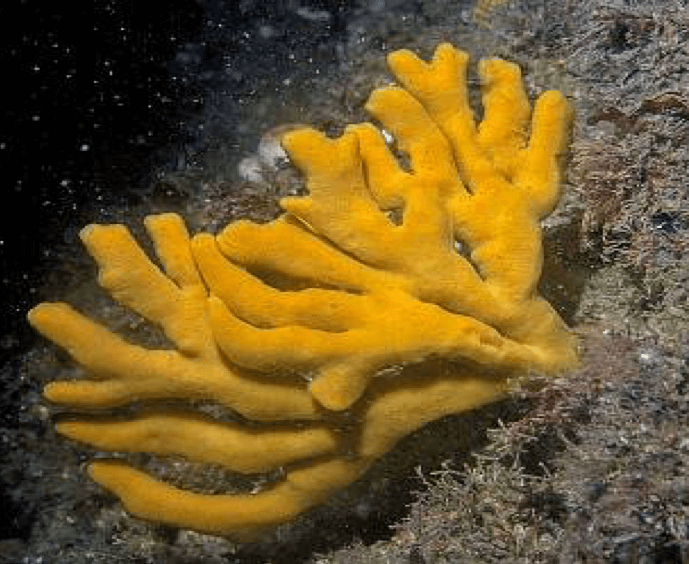
KINGDOM: Animal
PHYLUM: Porifera CLASSE: Demosponigiae
ORDER: Halichondrida FAMILY: Axinellidae
DISTRIBUTION: Mediterranean Sea
DESCRIPTION: It can be recognized by the shape of flattened branches in a fan shape that grow together and with dimensions that usually do not exceed 10-15 cm.
ENVIRONMENT: Fairly regular in caves at 2 / 10mt depth, on muddy bottoms and on rocks at 15 / 30mt.
CHARACTERISTICS: Filter feeder (4-8 cubic meters of water per day), it feeds on micro-organisms suspended in water. Above the body of this sponge cnidarians of the species Parazoanthus axinella frequently develop and cohabit with the poriferous.
GRANCHIO PIATTO
(Percon gibbesi)
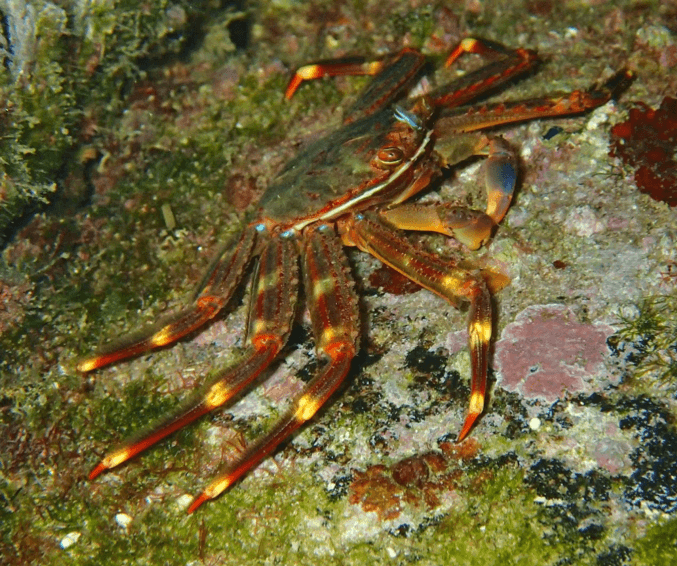
KINGDOM: Animal
PHYLUM: Arthropoda CLASS: Malacostraca
ORDER: Decapoda FAMILY: Grapsidae
DISTRIBUTION: originating from the Atlantic and Pacific Ocean, in the Mediterranean it is an alien species introduced relatively recently; reported the first time in Linosa in 2000.
DESCRIPTION: the carapace disc is deeply cut by the furrows of the antennae, the legs are provided with a row of spines on the front edge. Brownish carapace, golden yellow rings on the joints of the feet. Exclusively herbivorous species.
ENVIRONMENTS: rocky areas with large cracks to hide
DIMENSIONS: flattened discoid carapace, which in adults reaches 3–4 cm in diameter
MURICE TRONCATO
(Hexaplex trunculus)
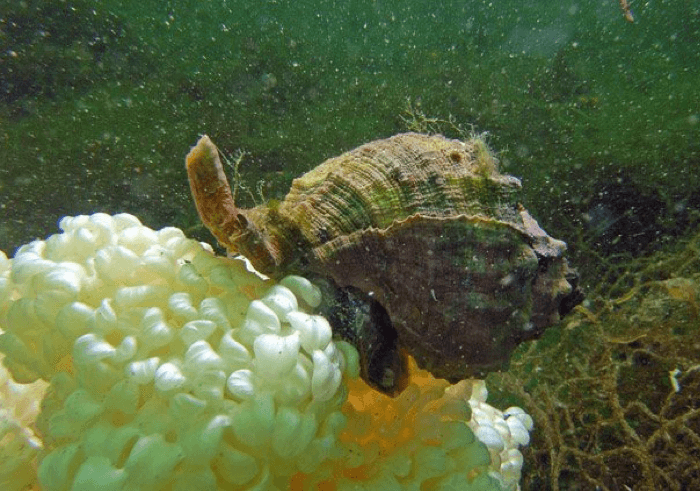
KINGDOM: Animal
PHYLUM: Mollusks CLASS: Gastropods
ORDER: FAMILY neogasteropods: Muricidae
DISTRIBUTION: Mediterranean Sea
ENVIRONMENTS: It is a common species on sandy, rocky and prairie beds of posidonia, up to a maximum of 100 m-
DESCRIPTION: The shell is large, robust and showy; quite slender. During the reproductive period, numerous individuals come together to lay groups of yellowish-white ovigerous capsules gathered in clusters that can reach the size of a ball. In the past the purple that was used to dye the fabrics was extracted from the Murici.
DIMENSION: It reaches a length of 8 cm.
STELLA MARINA
(Echinaster sepositus)
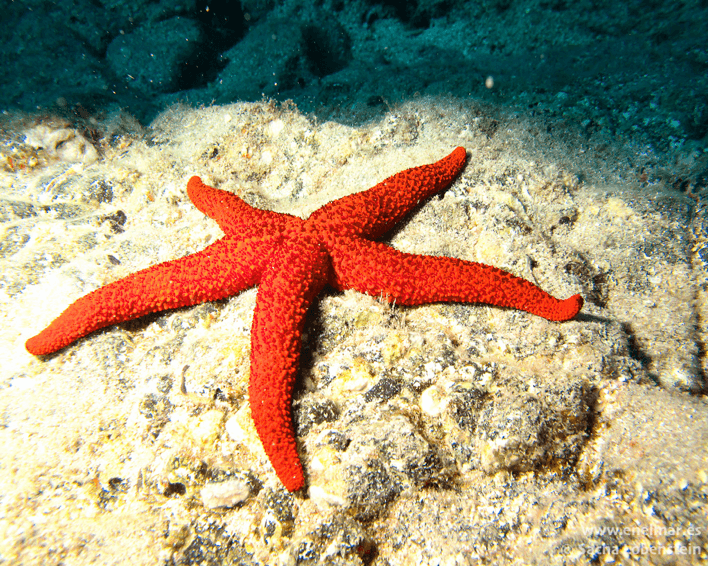
KINGDOM: Animal
PHYLUM: Echinodermata CLASS: Asteroidea
ORDER: Spinulosida FAMILY: Echinosteridoe
DISTRIBUTION: Mediterranean Sea (up to 200m)
DIMENSIONS: 12-24 cm
DESCRIPTION: The dorsal surface is bright red, the lower one is lighter. The five arms, equal, are punctuated by slight depressions. The body is covered with glands that give it an appearance of roughness.
CHARACTERISTICS: It moves on the bottom by means of ambulacral pedicels, operated by a complex aquifer system, which also regulates the movements of flexible arms. Reproduction is asexual and occurs for directly developing eggs.
MONODONTA TURBINATA
(Onsilinus turbinatus)
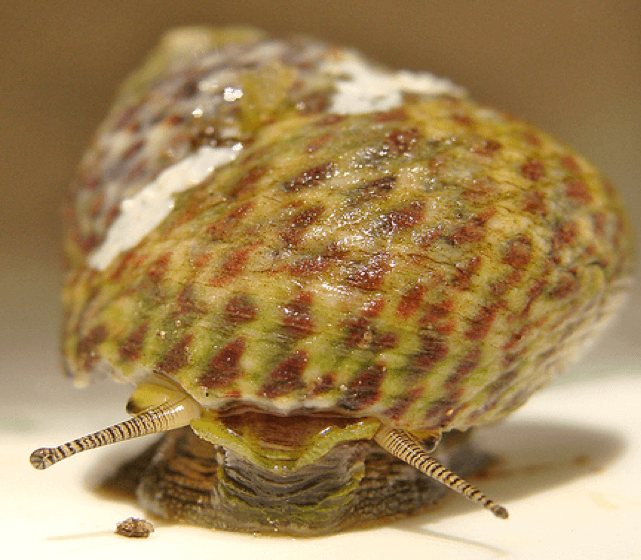
KINGDOM: Animal
PHYLUM: Mollusca CLASS: Gastropoda
ORDER: Archaeogastropoda FAMILY: Trochidae
DESCRIPTION: The shell is very robust, the background color is gray with purple-red or dark green streaks that follow the spiral.
HABITAT: rocky bottoms, and Posidonia meadows. It occupies mainly the mesolitoral plane and the intra-coastal one up to 10 m
DIFFUSION: Mediterranean Sea and eastern Atlantic Ocean
FEATURES: It has a tendency to get out of the water, even for a few hours, so in open aquariums it is not uncommon for it to fail to find its way back to the water and to be found on the floor. In the wild, after sunset it is common to find it on the emmerse rocks.
DIMENSIONS: 12-24 cm
PAGURO BERNARDO L’EREMITA
(Dardanus arrosor)
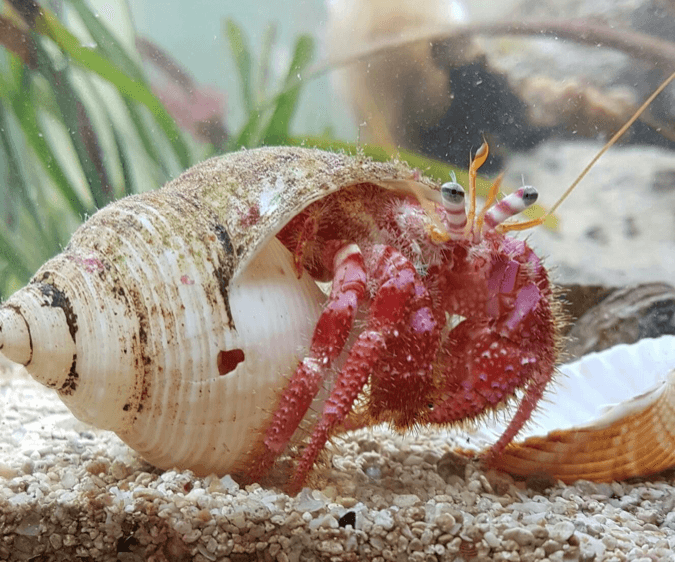
KINGDOM: Animal
PHYLUM: Arthropoda CLASS: Crustacea
ORDER: Decapod FAMILY: Diogenides
DISTRIBUTION: Mediterranean Sea and Eastern Atlantic
DESCRIPTION: It is a hermit crab with asymmetrical abdomen, large white ocular peduncles with red streaks and a chela larger than the other. The color varies from orange to red.
ENVIRONMENTS: it frequents rocky and sandy bottoms up to 80 meters deep.
DIMENSIONS: It can reach the maximum size of 8 cm in length
PARTICULARITY: During the growth phase the shell in which it lives changes. Accept any food of animal origin but above all mussels, small fish and shrimp pieces.
PATATA DI MARE
(Halocynthia papillosa)
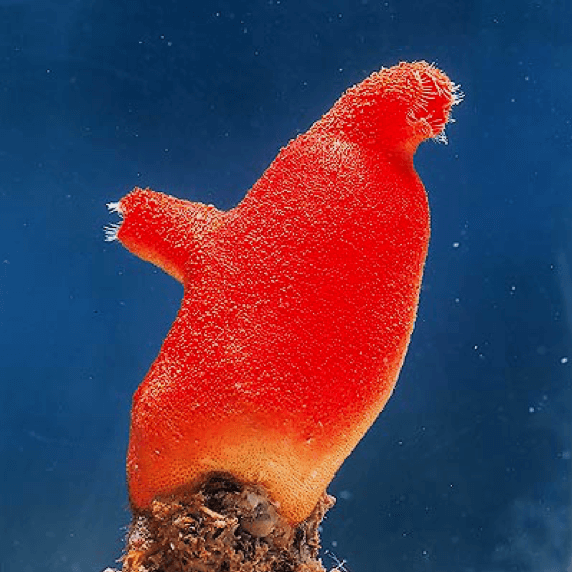
KINGDOM: Animal
PHYLUM: Chordata CLASS: Ascidiacea
ORDER: Stolidobranchia FAMILY: Pyuridae
DISTRIBUTION: It is very common in the Mediterranean Sea; widespread in the eastern Atlantic Ocean, in the South Pacific Ocean.
DESCRIPTION: The body has the shape of a sack. The tunic, leathery and rough to the touch, has a variable color depending on the depth and the light received: red in the illuminated parts, tending to pink or yellowish-white if in shadow. It has two siphons, the upper one inhalant (through which the plankton in suspension) and the lateral exhaling one.
ENVIRONMENT: It lives between the Posidonia oceanica or coralligenous prairies, from about 3 to 100 meters deep.
SIZE: 10-12 cm
POMODORO DI MARE
(Actinia equina)
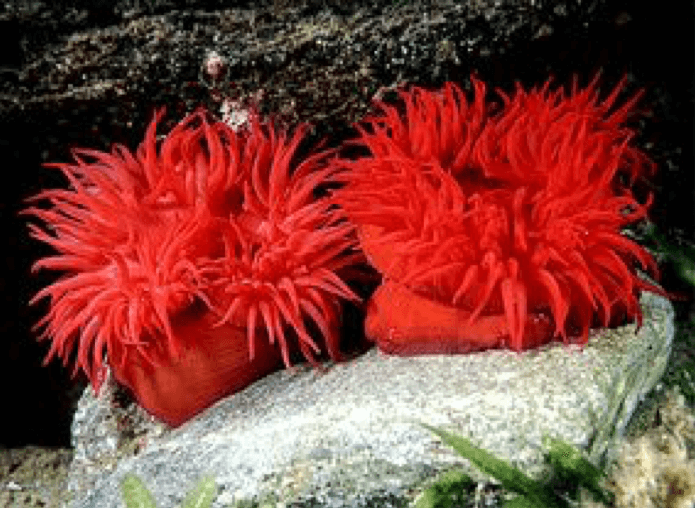
KINGDOM: Animal
PHYLUM: Cnidaria CLASS: Anthozoa
ORDER: Actiniaria FAMILY: Actiniidae
DISTRIBUTION: Almost cosmopolitan, it lives in the intertidal zone of the seas of the temperate area, where it populates the coastal rocks.
DESCRIPTION: It is a red-colored anemone, provided with about 200 short stinging tentacles. The body is cylindrical and has at its base a pedal disk wider than the overlying trunk. During low tide it often remains outside the water, taking on the appearance of a small red ball. When it is completely immersed, its tentacles are outlined.
ENVIRONMENT: He lives anchored to the rocks, but is able to move, albeit very slowly, slipping on the pedal disk
DIMENSION: Anemone of small or medium dimensions (3 – 9 cm)
POSIDONIA OCEANICA
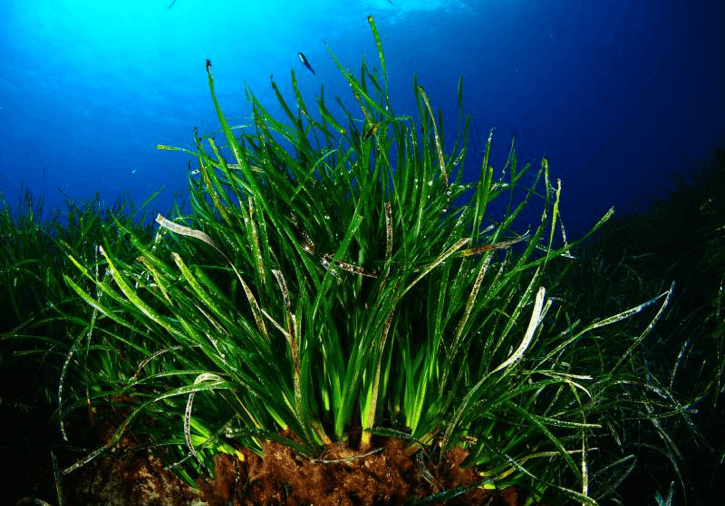
KINGDOM: Vegetable
PHYLUM: Spermatopyta CLASS: Monocotyledoneae
ORDER: Potamogetonales FAMILY: Potamogetonaceae
DISTRIBUTION: Mediterranean Sea.
DESCRIPTION: The younger leaves are green, while the older ones are brown.
DIMENSION: They form grasslands with a depth of 1 to 40 meters. The leaves can reach one meter in height.
DISTINCTIVE CHARACTERS: Today protected, it is considered a qualifying element of the state of the environment. The Posidonia settles both on sandy and rocky bottoms, in particularly clear waters. It withstands temperature changes well, but does not tolerate temperatures below 10 ° C or above 28 ° C. This plant is stenoalin, disappears near the fluvial outlets and is absent in the brackish areas.
SPIGOLA
(Dicentrarchus labrax)
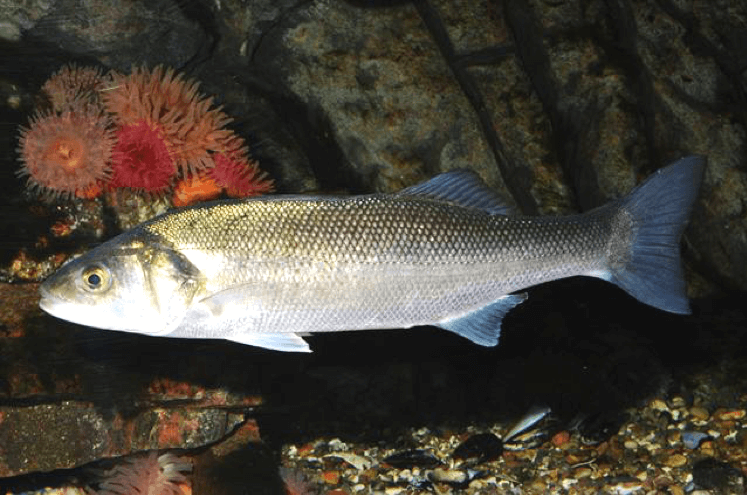
KINGDOM: Animal
PHYLUM: Chordata CLASS: Actinopterygii
ORDER: Perciformes FAMILY: Moronidae
DISTRIBUTION: diffused in the Atlantic, Mediterranean Sea and Black Sea.
DESCRIPTION: The bass has a rather tapered body, an elongated head, a large mouth and a fairly small eye. The dorsal fins are two, separated by a space. Obvious lateral line. The color is silvery on the sides with a white belly and a silvery gray back.
ENVIRONMENT: It is a strictly coastal species with both hard and sandy bottoms. Being very euryhaline, it regularly penetrates the brackish waters of lagoons and foci.
SIZE: The maximum size is 103 cm, average size around 50 cm. The maximum known weight is 12 kg.
SPIROGRAFO
(Sabella spallanzani)
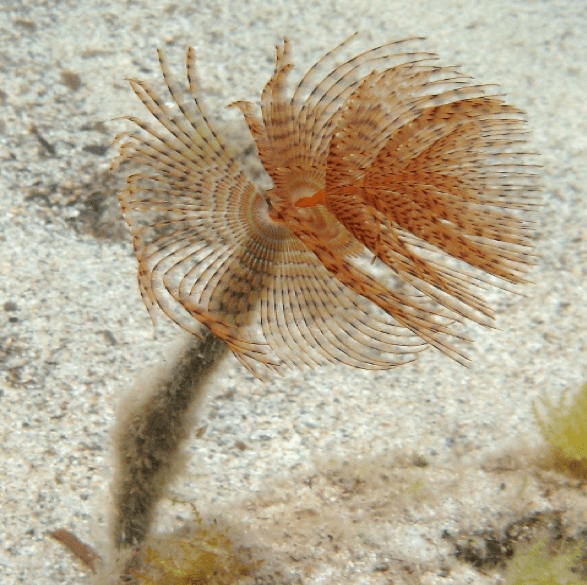
KINGDOM: Animal
PHYLUM: Annelida CLASSE: Polychaeta
ORDER: Sabellida FAMILY: Sabellidae
DISTRIBUTION: Mediterranean and Eastern Atlantic.
DESCRIPTION: The animal, with a vermiform body, lives inserted into the soft and flexible pergameneous tube (about 30 cm) which is fixed to the substrate, and from which a single large crown of spiral-shaped tentacles similar to a plume emerges. from yellow to brown with white, brown and reddish bands.
ENVIRONMENT: hard and muddy bottoms
SIZE: over 30cm in height
DISTINCTIVE CHARACTERS: Present in calm water up to 60 m. It can often be found also on the piers or in ports and under buoys.
GRANSEOLA
(Maja squinado)
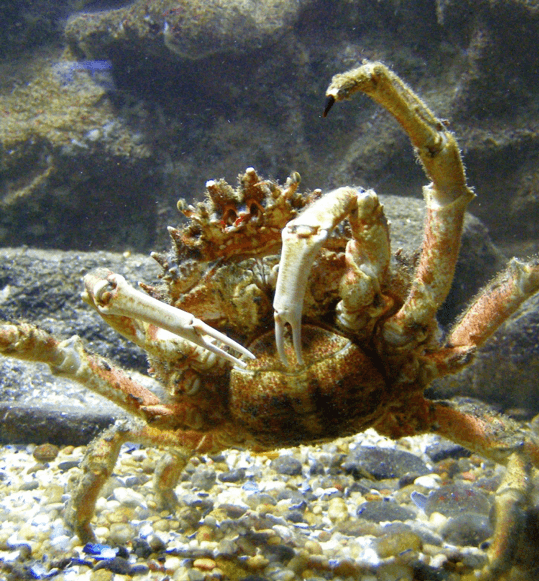
KINGDOM: Animal
PHYLUM: Arthropoda CLASS: Malacostraca
ORDER: Decapod FAMILY: Majidae
DISTRIBUTION: Mediterranean Sea
DESCRIPTION: Carapace brown-orange, sometimes red-orange, full of thorns with brown edges. Thin and long legs, suitable for movement on the sandy bottom. Small front claws, lighter tip. Exceptional camouflage, which allows it to hide perfectly between the algae and the colored rocks of the seabed. At constant periods the spider crab changes its carapace, through a wetsuit.
ENVIRONMENTS: It lives on soft or rocky surfaces rich in vegetation.
DIMENSION: Up to 25 cm in length and 18 in width
SPUGNA CANNA D’ORGANO
(Axinella cannabina)
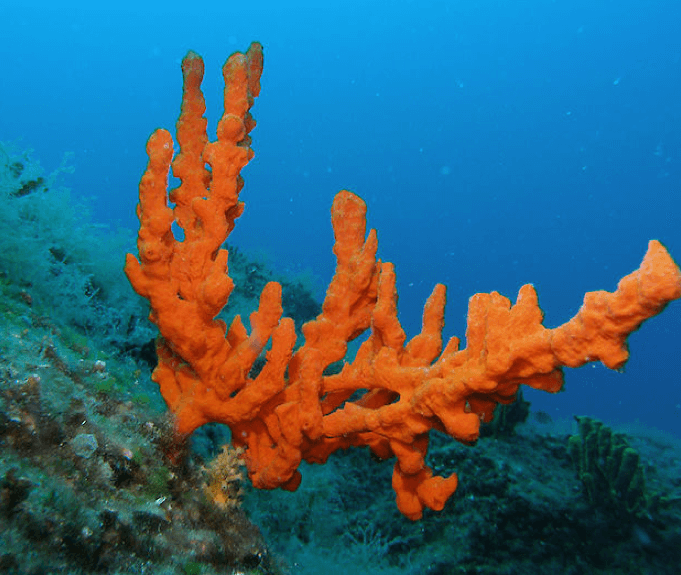
KINGDOM: Animal
PHYLUM: Porifera CLASSE: Demosponigiae
ORDER: Halichondrida FAMILY: Axinellidae
DISTRIBUTION: An exclusively Mediterranean species that in Italy is prevalent mainly in the South.
DESCRIPTION: Arborescent shape, it presents a very particular aspect, often with one or, at the most, two main trunks from which few branches branch out randomly. Color varies from yellow to orange. It is not uncommon to find on this sponge the zoantario Parazoanthus axinella that lives from epibionte.
ENVIRONMENTS: The species lives on rocky substrates from 10 to 50 m; it is typical of precoralligenous and coralligenous.
SIZE: can reach up to 60 cm in length.
STELLA GRASSA
(Asterina gibbosa)
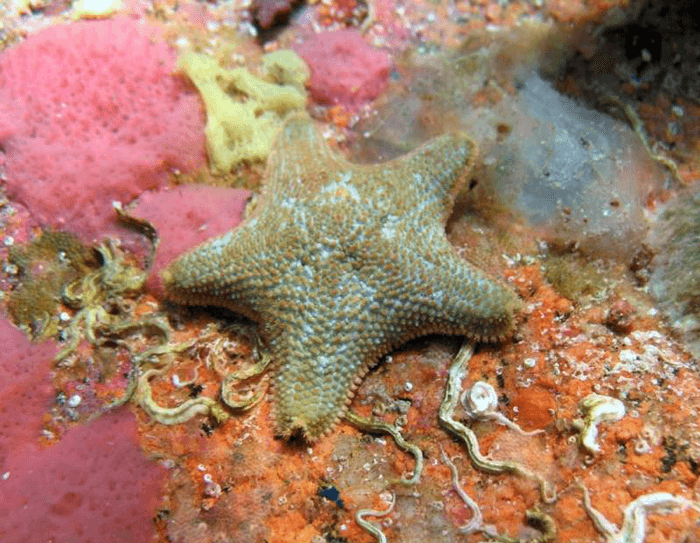
KINGDOM: Animal
PHYLUM: Echinodermata CLASS: Asteroidea
ORDER: Spinulosa FAMILY: Asterinidae
DISTRIBUTION: Mediterranean and eastern Atlantic.
DESCRIPTION: It is a small starfish, with short arms, usually with a greenish back and a yellowish lower surface. The back, of a finely grained appearance, is characterized by numerous barely noticeable tubercles. The thin, ambulatory pedicels protrude from the ends of the arms; the young specimens are males and become females with the growth (proterandric hermaphroditism).
ENVIRONMENT: It can be found in rocky or gravelly bottoms starting from very low depths. During the day it lives mainly under large stones or in caves.
DIMENSION: Diameter 3-5 cm.
ORATA
(Sparus aurata)
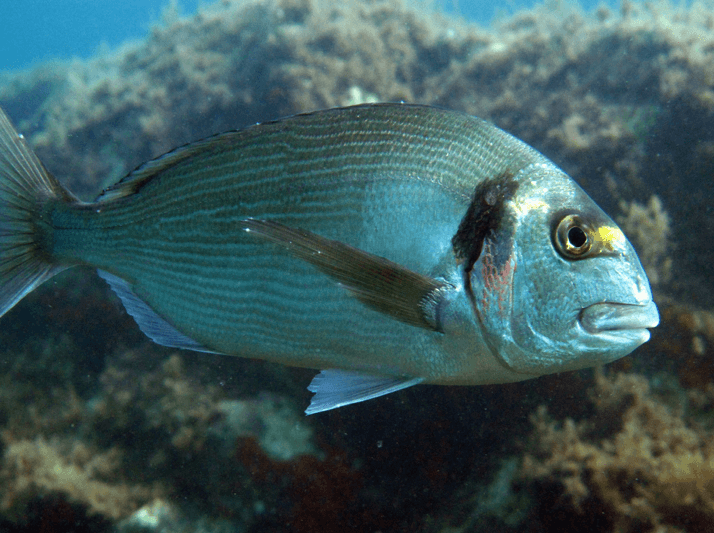
KINGDOM: Animal
PHYLUM: Chordata CLASS: Actinopterygii
ORDER: Perciformes FAMILY: Sparidae
DISTRIBUTION: Mediterranean and eastern Atlantic.
DESCRIPTION: The body is oval, elevated and depressed; very convex head profile. On the front of each jaw there are 4-6 large teeth. The back is bluish gray and the sides are silvery with thin longitudinal gray lines. A black and a golden band are placed between the eyes. Normally he leads a solitary life or in small groups.
ENVIRONMENT: Strictly coastal, it lives between 5 and 150 m from the coast, on hard or sandy bottoms. Very sensitive to low temperatures.
DIMENSION: maximum length 70 cm, but commonly between 20 and 50 cm; it can reach a weight of about 10 kg.

